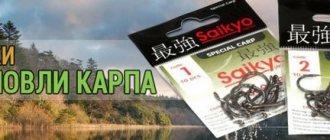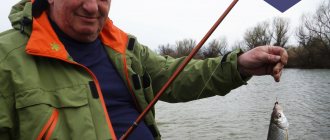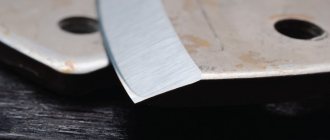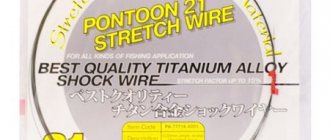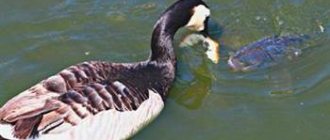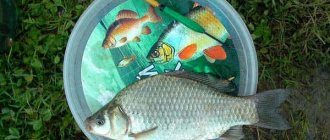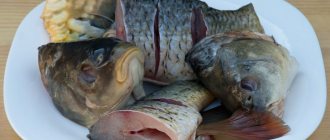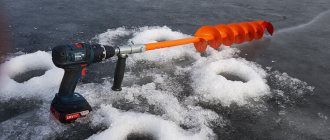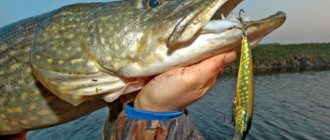Variety of shapes and characteristics
During the winter season, ice drill knives are a popular consumable item. Sometimes during one fishing trip two or even three sets fail. This is due to the fact that, as a rule, on all river beds the ice is simply saturated with sand and the instrument becomes completely unusable after a dozen holes. In this case, a fishing secret will help: bend the edge outwards with a metal object from the inside, but this will not help for long.
The following will save you from frequently replacing the cutting parts of the ice drill:
- Selection of high-quality tools and spare parts for them.
- Spare kits must be of the same brand, or an analogue, ideally suitable for the ice auger model.
- Proper use, transportation, cleaning and storage of equipment.
When purchasing you need to consider:
- Features of blade sharpening.
- General geometry.
- Heat treatment level.
- Steel sample.
Knife shape
Devices for making holes have gone through a significant evolutionary path over the last century - from a regular ice pick to high-tech portable ice drills. But progress does not stop there: manufacturing companies and private craftsmen are trying to constantly improve the tool. Especially often, the knives of the device become the subject of experiments; their shape, sharpening angle, and method of action are modified.
Different cutting edge shapes are most suitable for certain conditions - air temperature, ice thickness and density. Taking this into account, manufacturing companies produce ice drills with the ability to replace the cutting attachment. Specialized stores have a large selection of branded knives of various shapes, so purchasing a suitable modification is not very difficult. However, many home craftsmen prefer to make knives with their own hands. Let's look at the basic configurations of ice drill knives and which ones are best suited for specific circumstances.
According to their shape and design, knives are divided into the following types:
- universal;
- semicircular;
- spherical;
- toothed;
- stepped.
Each of these types has its own areas of application where the benefits are best revealed.
Universal
Universal, or flat, models. They work equally well on both dense and loose ice of varying thickness. This is one of the most common types of ice drill knives today . Their peculiarity lies in the different angles between the cutting edges of the knife. The closer this angle is to 90°, the better the tool works on soft ice. By decreasing the angle, we get a tool that is more suitable for cutting dense ice at low temperatures. Depending on the characteristics of the ice conditions, it is recommended to select the angle between the cutting edges.
It should be borne in mind that too sharp knife corners are most susceptible to breakage. This can happen if the drill suddenly encounters solid inclusions in the ice - frozen branches or pebbles. Installation and fastening to the auger is done using a bolted connection, which is much more reliable than a screw connection. The versatility of such knives lies in the similar arrangement of holes in models from different manufacturers. The universal drill knife Tonar-100 easily fits models of other companies, for example, the Barnaul 100 mm “Skat”.
Semicircular
Semicircular models are especially popular among novice hobbyists, as they can work well both during thaws and in severe frosts. The use of such structures when drilling ice allows you to reduce the applied loads, as a result of which your hands get less tired. There are modifications of semicircular knives specially designed for drilling wet ice during the spring thaw. They easily pass through the softened top layer filled with moisture, without playing or roaming to the sides.
Russian manufacturers use the same standards, as a result of which semicircular knives from different companies can be interchanged. For example, ice drill knives Nero-130 are suitable for Tonar-130, but this cannot be said about imported models. Among the disadvantages is the difficulty of sharpening yourself. It is almost impossible to do this correctly, especially in the field. Therefore, when going out on the ice, it is recommended to have a spare set of knives with you, which can be installed if the main set becomes dull.
Spherical
They are distinguished by a convex, semicircular shape of the main cutting edge. This allows you to drill both hard and soft ice equally well - its density in this case does not have much effect on the operation of the tool. A serious disadvantage of such models, like semicircular knives, is the difficulty of sharpening. Only a person with appropriate experience can sharpen a spherical edge correctly. Therefore, it is recommended to trust the work to professionals, otherwise there is a chance of simply ruining the cutting part of the drill.
Spherical knives are most often used on foreign-made drills. They can be found on the Finnish Rapala and Swedish Mora instruments. Another disadvantage of spherical models is the non-separable design of the drill head - the knives are attached to it with rivets. Therefore, if at least one knife fails, the entire cutting head has to be replaced. As a result, the replacement will cost the fisherman about the same price as buying a new Russian drill.
Serrated
Tooth modifications have teeth on the cutting edge that make it easier to crush hard ice. Such models have proven themselves well on “dirty” ice containing inclusions of small pebbles and sandy deposits. In such conditions, spherical or utility knives can quickly become dull. Considering that when searching for fish, sometimes you have to make dozens of holes, their constant sharpening can take up a significant part of the fisherman’s time.
Another convenience of a serrated knife is that you can make it yourself from a used flat knife. To do this, teeth are cut out on the edge, the number of which varies - from one to ten.
Stepped
Tools with a similar cutting edge are designed specifically for use in severe frosts, on dry, dense ice. When the air temperature drops to –15°, the properties of the ice change and its hardness increases sharply. As a result, drilling a hole takes more time and effort. Stepped knives, thanks to cutting edges spaced apart in space, crush hard ice more successfully. However, during a thaw on loose ice, the efficiency of their work decreases.
Serrated and spherical knives
Today on the fishing equipment market you can see a variety of drill cutters. The most common:
- Serrated.
- Oval.
- Universal.
- Stepped.
Which knives are best for an ice drill, everyone chooses for themselves.
All of them are designed for different surface types and weather conditions. To choose the right ones, you need to know how they differ:
Serrated blades are an indispensable assistant in the fight against heavily moistened ice. They will help out when winter is already receding and water from the spring sun begins to wash small channels on the surface of the reservoir, abundantly saturating the ice layer. Small contact area reduces drag force. It's worth noting that the blades need to be "break-in" (approximately 30-40 holes), during which time the drilling can be a little aggressive. For some, when it gets from the ice into the water.
Oval (spherical) - suitable for almost all possible types of ice cover on water bodies. As a rule, spherical ones are included in the basic kit with most ice drills from well-known companies that are present on the Russian market. Unfortunately, this form has one critical drawback: the cutters become dull rather quickly, and it is almost impossible to sharpen them at home.
The cost of sharpening from a professional is, as a rule, 50% of the price tag for new ones in the store, and it is undesirable to subject them to this procedure more than three times.
Ice screw knives. Which ones are better?
All fishermen who are passionate about ice fishing know that the winter fisherman’s first friend is an ice screw. And drilling depends on the type and quality of the knives. Over the long years of the evolution of tools for making holes in ice, man went along the path from an pick to an auger-“spoon”, then they came up with a “ring”, followed by a “cylinder” or the so-called “glass”. As the design of ice drills changed, the cutting surface also changed. But progress does not stand still. And now all winter fishing enthusiasts use auger ice screws. Modern augers have undergone many improvements over the years, but even more experimentation has been done with ice auger blades. After all, it is not a drill that drills, but the correct cutting surface of removable knives or a replaceable removable head.
To the simple question “which knife for an ice drill to choose,” you will answer me that now this is not a problem. You come to the store and say what kind of drill you have, they offer you knives. But not everything is as simple as it seems at first glance. In fact, there are a wide variety of ice drill knives on sale. But they all differ in price, shape, steel, sharpening angle, purpose and much more, not to mention the location of the mounting holes. With such variety, of course, you will need a guide to choosing knives.
Let's talk about the shape of ice drill knives
For Russian and imported ice drills, manufacturers now produce several forms of knives, such as
- spherical;
- semicircular;
- universal;
- stepped;
- serrated.
All of them are working, but are designed for different models of drills and different drilling conditions. About all types in order.
Knives for ice auger LR-130 Tonar 290 for 1 set. Knives for ice auger ICEBERG-130(R) for V2.0/V3.0 Tonar 435 for 1 set. Knives for ice auger LR-130 (SKAT) Tonar 170 for 1 set. Knives for ice auger ICEBERG-130(R) for V2.0/V3.0 (wet ice) Tonar 435 for 1 set. Knives for ice auger HS-130 (semicircular - wet ice) Tonar 315 for 1 set. Knives “Light Ice” 130(L) Tonar 315 for 1 set. Knives for ice auger HS-130 (SKAT) Tonar 165 for 1 set. Knives for ice auger HS-130 (semicircular) Tonar 315 for 1 set. Knives LR-130(R) Tonar 290 for 1 set. Knives LT-180(R) TORNADO Tonar 415 for 1 set. Knives LR-150(R) Tonar 330 for 1 set. Knives ICEBERG-160(R) V3.0 Tonar 410 for 1 set. Knives for ice auger LR-100 Tonar 245 for 1 set. Knives HELIOS 150(L) (semicircular - wet ice) Tonar 340 for 1 set. Knives for ice auger LR-150 Tonar 330 for 1 set. Knives HELIOS 130(R) (semicircular / wet ice) Tonar 315 for 1 set. Knives LR-150(L) (SKAT) Tonar 190 for 1 set. Knives for ice auger HS-110 (semicircular) Tonar 280 for 1 set. Knives for ice auger HS-150 Tonar 325 for 1 set. Knives for ice auger LR-100 (SKAT) Tonar 165 for 1 set. Knives “Light Ice” 150(L) Tonar 345 for 1 set. Knives for ice auger LR-180 (in case) Tonar 435 for 1 set. Knives for ice auger HS-110 (semicircular - wet ice) Tonar 280 for 1 set. Knives for ice auger LR-080 Tonar 210 for 1 set. Knives ICEBERG-130(L) for V2.0 (wet ice) Tonar 435 for 1 set. Knives LT-180(L) TORNADO Tonar 415 for 1 set. Knives ICEBERG-130(L) for V2.0 Tonar 435 for 1 set. Knives LR-100(R) Tonar 245 for 1 set. Spacer for knives for LR-100 Tonar 130 for 1 set. Knives ICEBERG-110(R) for V2.0/V3.0 Tonar 420 for 1 set. Knives ICEBERG-110(R) for V2.0/V3.0 (wet ice) Tonar 420 for 1 set. Knives INDIGO-120(R) (wet ice) Tonar 390 for 1 set. Spacer for knives for LR-130 Tonar 130 for 1 set. Knives INDIGO-120(R) Tonar 390 for 1 set. Knives LR-080(L) SPORT (left rotation) Tonar 210 for 1 set. Knives ICEBERG-110(L) for V2.0 Tonar 420 for 1 set. Knives ICEBERG-110(L) for V2.0 (wet ice) Tonar 420 for 1 set.
Spherical knives
– such knives are found on Mora and Rapala ice screws. These are the two most famous foreign companies engaged in the production of ice augers and knives for ice augers: Mora from the Swedish company Ericson and Rapala from the Finnish international concern Normark. The spherical shape allows the angler to easily drill through both dry and wet ice, regardless of its density. Spherical knives have only one disadvantage - sharpening. It negates all the advantages of Mora's ice drill knives. This is problematic to do at home, and you have to replace the entire cutting head, since they are not sold separately. The cost of such a replacement will cost you the same price as a new ice auger with a set of knives from a domestic manufacturer.
Semicircular knives
for ice augers are especially popular among amateur fishermen. They are created for those who go fishing in both frost and thaw. A drill with semicircular knives puts less strain on your hands when drilling. Knives of domestic production have the same center-to-center distances of the mounting holes and therefore knives for the Tonar 130 mm ice auger will also fit the Nero 130 mm ice auger. The advantage of semicircular knives marked “wet ice” is manifested on the wet, spring surface of reservoirs simply splashing with moisture. Biting into the upper crust, they easily pass through wet ice. Semicircular knives are also difficult to sharpen yourself, but their price is several times cheaper than imported ones. Therefore, you can always have a spare set of knives with you, and upon arrival from fishing, give them to professionals for sharpening.
Utility or flat knives
. There are a large variety of such knives from different manufacturers. The difference between the models is the size of the angle between the two cutting surfaces. The closer this angle is to 90 degrees, the more suitable such knives are for drilling into soft ice. By reducing the angle, the knives cut hard ice more aggressively in cold weather. But the edge has an acute angle and is more brittle when dropped sharply onto ice or when it gets into a hard foreign layer of ice (branches, pebbles). The center-to-center distances of the holes of such knives are also the same for many manufacturers, so the knives for the Tonar 100 ice auger will fit “100th” diameter ice augers from other manufacturers. An example of such flat knives produced in Barnaul are Skat ice drill knives.
Their peculiarity is that they are screwed on. This is a more secure fastening than a screw.
Step knives
Recommended for cold weather and hard dry ice. As the temperature drops below -15C, the properties of the ice cover change, and it is at this time that stepped knives will help you; they can easily solve the tasks. Crushing hard ice, they quickly reach the water. At warmer temperatures, unfortunately, they are not so effective, but we also have frosts for a couple of months, which means that step ones should be in the arsenal of a real winter fisherman.
Serrated
or, as they are also called,
“Beast” knives
for ice drills - this model is interesting because it can be made from a flat knife that has already been used. To do this, you need to cut “toothed” grooves across the cutting surface. In practice, the critters performed well on a river with sandy sediments in the ice.
For the convenience of buyers, manufacturers write that specific knives are made for dry or wet ice. As mentioned above, the difference is in the sharpening angles. In practice, different angles of attack of knives give different drilling speeds for the same ice drill. You've probably noticed that with only knives the drill moves smoothly and you reach your water target without any effort. And when using other knives, under the same weather conditions, the drill passes through the ice layer faster by a couple of turns, but a little more effort may be expended.
We are all different, so you should choose both the ice auger itself and the knives for it. I prefer fast aggressive drilling, while others find it more pleasant to make a little more turns of the handle without making any effort. But not everyone knows that you can change the angle of attack without changing the knives. This can sometimes come in handy on a pond when the air temperature and ice structure changes during fishing. When the temperature dropped sharply to -20C, Russian craftsmen came up with the idea of installing a spacer for knives
, thereby increasing the angle. The method is effective, but not very reliable. The knife no longer holds tightly and becomes more brittle.
How to sharpen ice drill knives
When you go out on the ice, all sorts of situations happen. You can accidentally get on a frozen stick or a layer of sand in the ice or some other solid foreign bodies, thereby damaging your drill. I always have several sets with me. Some are the same as those already screwed, and two sets for other conditions. But what to do if you don’t have any spare ones with you? How to sharpen the knives of an ice drill yourself, because sharpening knives when fishing is problematic, but you can correct the cutting surface in order to somehow finish the fishing. To do this you will need a small flat abrasive stone. Without unscrewing the blades from the ice drill, run the block along the cutting surface along and down several times. This correction will save the fishing, but upon return the knives will have to be sharpened. If you do not have professional skills, then we do not recommend sharpening ice drill knives yourself, because you need to press the entire surface to be sharpened onto the abrasive at exactly the same angle, and not everyone can do this and failures in sharpening appear.
To make sure of the quality of the restored knives, you can carefully take the knife with two fingers and run it along a sheet of newspaper. It should be cut, then the knives can be put back in place.
With good knives, not only meter-long river ice, but also the thicker ice of the Far North are not scary. I’ll tell you one more “secret”, there are many varieties of knives for an ice auger of 100, but instead of the hundredth size, you can buy knives for an ice auger of 130. Drilling will not be so comfortable (the auger will move left and right when drilling), but the hole will have a larger diameter. This trick can be used when you find a fish, but it just doesn’t fit into the hundredth diameter and you don’t have a second drill on hand, but you have spare knives of a larger diameter. The center-to-center distance on knives of 100 and 130 diameters is the same - 16 mm.
Which knives are suitable for Barnaul ice screws Tonar
Correspondence table of knives to TONAR ice screws
Recommendations for installing knives
And in conclusion, a few more recommendations for installing knives on an ice auger.
First you need to unscrew the old knives from the drill. If they are rusty and cannot be unscrewed, you can gently tap them with a rubber mallet and unscrew them. If this does not help with “sticking”, you can try soaking it with kerosene or WD-40. To do this, pour it into the mounting holes on the back of the knife platform and leave it for a couple of days. The main thing when dismantling is not to rip off the screws or break the knives, otherwise you will have to drill out these screws later, and you won’t be able to restore the knives like that.
Prevent sticking
It’s always easier than dealing with its consequences. There are two ways here too.
The first is to wind several turns of thread with Fum tape when installing new knives.
. The tape will prevent it from rusting and sticking, and will also help the screw to fit more tightly. Knives screwed with a seal will not unscrew on their own. But don’t forget, the winding is disposable and when changing knives, the fum tape needs to be updated.
Another way is to apply thick graphite lubricant to the threads
For further ease of use, you can immediately replace the slotted screws with hexagon screws. The wrench itself is much smaller than any screwdriver, and the force transferred to the screw is greater than to slotted screws. If a regular screwdriver slips off a screw, injury may occur. The hex key hardly slips. When installing and removing knives, you must protect your hands from cuts.
Having removed the old knives, we take out new ones. Knives for Barnaul ice screws used to be produced in a box, wrapped in oiled paper, but now they come in a lightweight blister that does not allow moisture to pass through. New screws are included with the knives. Use them or replace them - it's your choice. But it is best to tighten new knives with new screws, and leave the old ones complete with the old knives. You need to install the knives on the ice auger in the same way as the previous ones.
Correct installation of knives on the Tonar ice drill
identical to drills from other manufacturers. If you have a new drill in your hands and no knives are installed on it, then first unscrew the screws from the head of the ice drill. The knife should be positioned with the cutting edge up towards the ice drill head (as a hint - chamfers for screws). The screws are tightened in relation to the vertical drill from bottom to top. The area under the knives and the knives themselves must be clean. Screws are well tightened. Otherwise, you can throw off the correct angle. The blades of the knives should move towards each other.
Tips for storing ice augers and knives for them
- When transporting an ice auger, always wear case
on knives. This will protect you from cuts, and if the drill falls, the knives will not break.
- It is better to take with you on a fishing trip a screwdriver that matches your screws, or a wrench, a piece of abrasive stone, a spare set of knives and a rubber hammer.
- When fishing, after drilling a hole, the drill should not be placed on the ice. There are several reasons for this. Firstly, for security reasons. Each of you can remember several stories of falling on a lying drill and open knives of your friends, acquaintances or “acquaintances of acquaintances”. Secondly, lying wet knives freeze, snow sticks to them, after which it becomes difficult to drill with them. But if, immediately after drilling a hole, you drill a drill nearby, the knives will remain dry and clean. It is enough to cross the ice literally 10 centimeters.
- Even if your knives are frozen, under no circumstances should you hit them with metal objects, such as a ladle or a regular hammer. This can be dealt with by either gently tapping the frozen ice with a hammer with a rubber tip, or lowering it into a hole where the water will help the knives thaw.
- When you approach the intended fishing spot and lower the drill onto the ice to drill a hole, do not abandon it. No need to chisel the ice with knives - they have the very tip of the knife breaks
and this makes them work worse.
- You cannot drill old holes. It's better to drill a new one nearby. Pulling a fish a meter or two is easier than removing a jammed drill. The ice structure in a frozen hole is not uniform and drilling is much more difficult.
- If strangers come up to you and ask for a drill to drill a hole, it’s better to help and drill it yourself. After all, there is no certainty that your knives won’t be broken simply due to your inability to handle an ice auger.
- There is no need to put any effort into the drill. If the knives “whistle” on the ice, then pressure on the drill will not help. It’s better to look at the knives, most likely you need to tighten the loose ones or replace the dull ones, but do not put pressure on them. Whole knives can always be sharpened, but broken ones are much more difficult to restore.
- At the end of fishing, it is better not to tap the ice auger and knives against frozen ice. If possible, bring it into a warm place so that it thaws on its own. Then wipe the ice auger and knives dry to prevent them from rusting during storage.
- When putting the drill away for summer storage, be sure to lubricate the knives with machine oil.
Winter fishing is an excellent form of recreation. But before you can get to the fish, you need to drill through the ice cover. This means you should have a reliable friend in your hands - an ice screw. Barnaul knives for ice screws produced by the Tonar Group of Companies are made wisely. We know everything about winter because we live where winter is longer than summer. And for twenty years now we have been working on improving ice drills and knives for them.
Utility and step knives
Universal - also called flat, deserve the attention of anglers due to their ease of maintenance. It’s easy to sharpen and straighten the blades yourself, thereby avoiding additional costs for the services of a professional. But when working with a flat blade, you will have to put in much more effort to drill the hole.
Ideally, it is better to take these knives with you to the pond for backup, and not as your main equipment.
Stepped - this equipment is indispensable when the temperature drops below -15 °C. Two blades located side by side create a crumbling effect, which for frost-hardened ice is much more effective than a cutter, without unnecessary loads. In warmer temperature conditions, these auger blades are ineffective. Sharpening them yourself is not as easy as flat ones, but it is possible.
Reviews from people
Last season the Yaroslavskys caught my attention. All the inconvenience that they caused me arose due to the insufficient thickness of the blade (about 3 mm). Because of this, it was not possible to screw in the countersunk screw completely and, as a result, the screws were constantly being unscrewed and I spent the entire fishing trip with a Phillips screwdriver at the ready. They cut well enough, but this running around with constant tightening of the screws completely blurred the whole picture.
Alexei.
I have been a fan of Barnaul knives for a long time. They last a long time, drill well and quickly, I had a complete set. But I recently bought an imported ice drill and these blades will no longer fit on overseas equipment, so I immediately bought a Swedish storage unit. The spare knives were not sharpened as well as the set of equipment itself, so I had to spend money on the services of a master.
Basil.
I have been using Tikhvin knives for a long time and am very pleased.
I also sharpen it myself using an abrasive stone or sandpaper. The main thing is to position the blade at the correct angle, sharpen only in circular movements and follow the sequence of edge processing, then the result will be no worse than in the workshop. When fishing, it is better to take several types of blades, and at night I advise you to use universal knives. Alexander.
